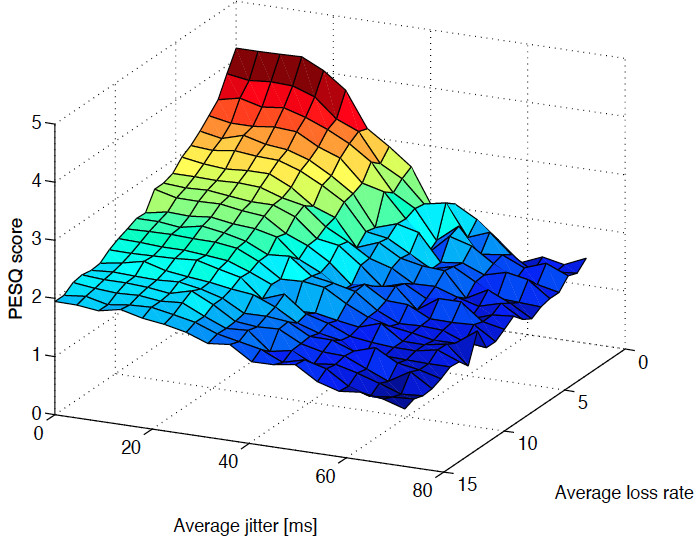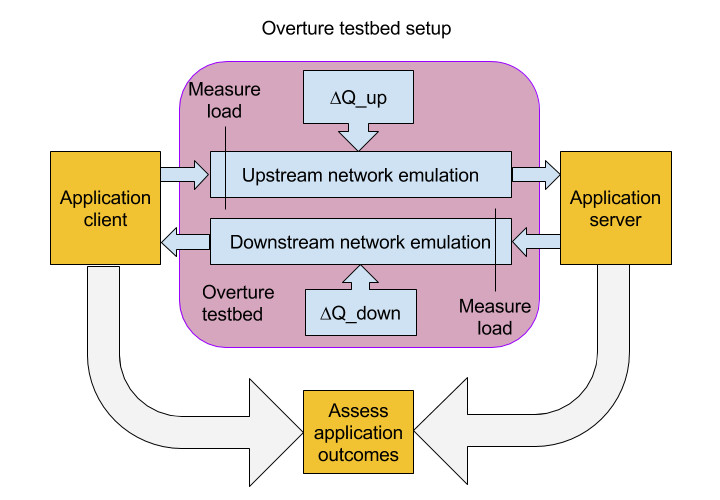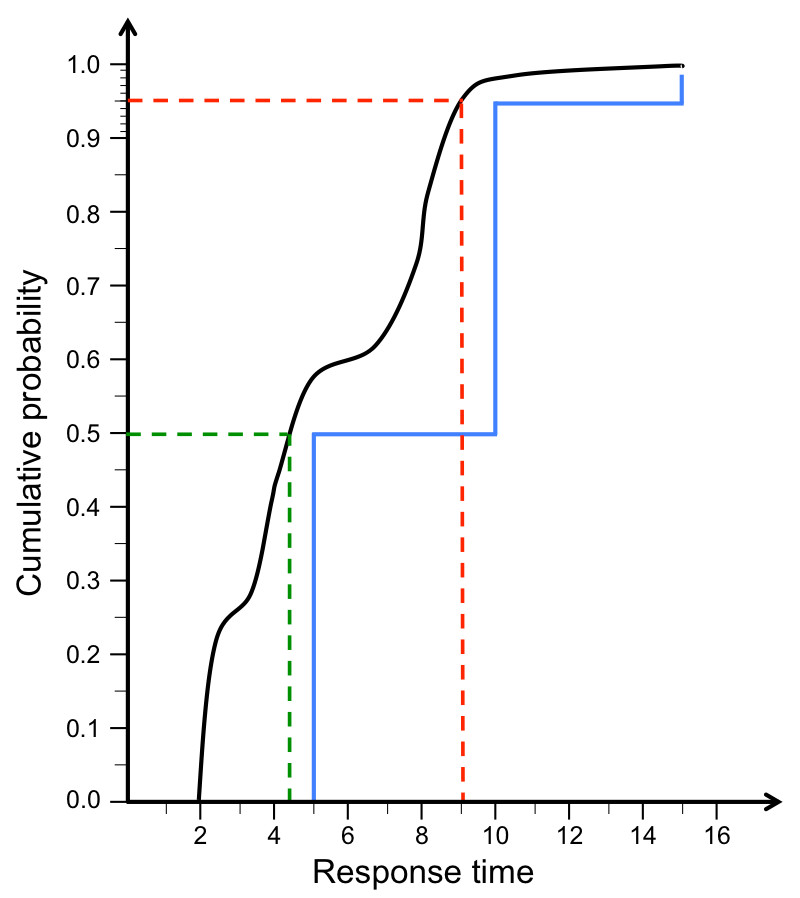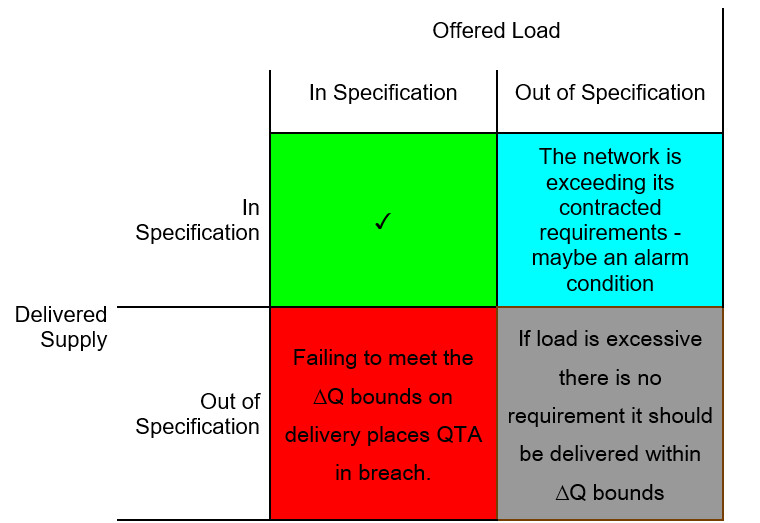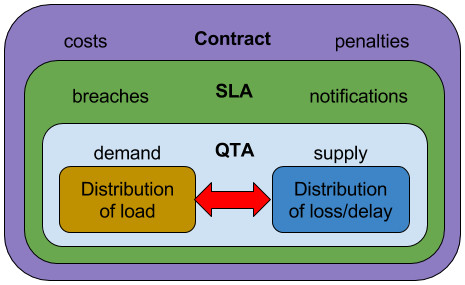Performance Contracts in SDN Systems
Peter Thompson and Neil Davies, Predictable Network Solutions Ltd.
IEEE Softwarization, May 2017
Abstract
SDN virtualizes connectivity and access to the underlying bearers. This enables more variety of routes and new ways to share the bearers to meet customer demands at lower cost. However customers will need assurances about the fitness for purpose of the delivered service for their critical applications. This requires new ways to quantify their requirements and to measure the delivered service that go beyond simple notions of bandwidth/capacity.
Dependability of network performance
How can users of a network have confidence that it is delivering satisfactory performance? In a traditional context, where network configuration changes only occasionally, this can be achieved through testing. With SDN, however, where the network configuration is highly dynamic, this approach has limited applicability. Either tests must be run very frequently, thereby imposing load on the network, or the user must accept that most network configurations are untested. This is an issue for both the SDN user and the SDN supplier: how does the user know what capacity and SLA to ask for; and how can the supplier decide what level of statistical multiplexing they should target?
Therefore, to maintain user trust, the use of SDN requires a much more proactive approach to quantification and qualification of performance, which needs to be embodied in service contracts. This needs to be based on a more precise definition of performance, including how this impacts the user.
The nature of ‘performance’
‘Performance’ is typically considered as a positive attribute of a system. However, a ‘perfect’ system would be one that always responds without error, failure or delay; real systems always fall short of this ideal, so we can say that the quality of their response is impaired relative to the ideal (such ‘quality impairment’ is thus a privation).
Performance has many constraints, starting from the fact that doing anything takes time and uses resources. Geographical distance defines the minimum possible delay; communication technology sets limits on the time to send a packet and the total transmission capacity; and sharing of resources limits the capacity available to any one stream of packets. The design, technology and deployment of a communications network (which is made more dynamic by SDN) sets the parameters for a best-case (minimum delay, minimal loss) performance at a given capacity. This is what the network ‘supplies’, and this supply is then shared between all the users and uses of the network. This sharing can only reduce the performance and/or the capacity for any individual application/service. Networks share resources statistically and so the resulting quality impairment is also statistical.
Since quality impairment is statistical, 100% delivery is unachievable - and the underlying bearers only have ‘N nines’ availability in any case. Performance thus needs to be considered statistically - but not as averages, as we shall see below.
Performance Requirements
Typical audio impairments that can affect a telephone call (such as noise, distortion and echo) are familiar; for the telephone call to be fit for purpose, all of these must be sufficiently small. Analogously, we introduce a new term, called ‘quality attenuation’ and written ‘∆Q’, which is a statistical measure of the impairment of the translocation of a stream of packets when crossing a network. This impairment must be sufficiently bounded for an application to deliver fit-for-purpose outcomes; moreover, the layering of network protocols isolates the application from any other aspect of the packet transport. This is such an important point that it is worth repeating: the great achievement of network and protocol design (up to and including SDN) has been to hide completely all the complexities of transmission over different media, routing decisions, fragmentation and so forth, and leave the application with only one thing to worry about with respect to the network: the impairment that its packet streams experience, ∆Q.
The impact of any given level of impairment depends on the particular protocols that an application uses and on the time-sensitivity of its delivered outcomes. For example, here is a graphical representation of the effect of varying levels of delay and loss (parameterized by the mean of uniform distributions) on the means and 95th centile of the time to complete a 30kB http 1.0 transfer (contours are labelled in seconds):
Here, on the other hand, is a plot (measured by a researcher at CERN) of the PESQ score of an H.264 audio decoder as a function of the loss rate and jitter of the packet stream:
VoIP is sensitive to jitter whereas HTTP is not; how can we characterize the delivered service in a way that applies to both? In principle, the answer is to use the complete distribution of packet delays (from which the mean delay, jitter or any other measure can be derived), together with information about packet loss, corruption, out of sequence delivery and so forth. While this works mathematically, applying this practically requires some further ideas, which we discuss in the next section.
Quantifying performance
Measuring ∆Q
One approach to practically measure ∆Q is to inject a low-rate stream of test packets and observe their transit times at various observation points. By keeping the rate of the stream low it is unlikely to materially affect the instantaneous utilization of any resources. The distribution of packet delays (and the proportion of losses) provides a measure of ∆Q. On the assumption that packets do not overtake each other and that the test packets are not given any special treatment, measuring the ∆Q of the test stream provides a sample of the ∆Q of all packets following the same path. The figure below shows the cumulative distribution function of just such measurements made between two points 1000 miles apart, connected by core network links:
Such data has structure that can be unpacked to expose a great deal about the operation of the network path, but the point here is that the abstract idea of ∆Q can be realized in practice, and provides a single measure of network performance that can be related to the likely behavior of any application sending packets along the same path.
Quantifying the impact of ∆Q
So, ∆Q can be measured, but how can we establish what ∆Q is or is not acceptable for any particular application? Fortunately, the UK public body InnovateUK has funded the development of a generic test environment in a project called Overture (project no. TP710826). This is illustrated in the following figure, which shows client and server components of an application (more complex configurations can also be used) exchanging packets through the testbed. The upstream and downstream ∆Q can be controlled (and varied) independently; combining this with a measure of how acceptable the application performance is (that may be subjective) sets bounds on the ∆Q such an application can tolerate. To completely characterize the application performance impact of network ∆Q as shown above for http and VoIP is a daunting task, but establishing a broad envelope of acceptability is quite straightforward. This can be captured in a fairly simple specification, such as:
- 50% delivered within 5ms
- 95% delivered within 10ms
- 99% delivered within 15ms
- 1% loss acceptable
At the same time, the load imposed on the network by the application can also be measured, which is important for completing the performance contract, as described below. Note that ‘load’ is also characterized by a distribution, not just an average, which is important for the ability of the network to carry this load and still deliver acceptable ∆Q, for example deciding how much capacity to allocate in excess of the mean.
Describing the contract
QTA
Given the information above, we can formulate a technical specification of the relationship between application load and network performance. We call this a ‘Quantitative Timeliness Agreement’ or ‘QTA’ which consists of a set of constraints on the distribution of load and the distribution of loss and delay. Considering the distribution of loss and delay, combining an application requirement as described above with a measure of delivered performance at the SDN service layer would produce a pair of CDFs (Cumulative Distribution Function) such as shown below:
In this case, we can see that the measured performance is unambiguously ‘better’ than the requirement (for example, 50% of packets are delivered within about 4.2ms whereas the requirement was within 5); this is the criterion for the network to have ‘met’ the QTA. The constraints on the application load on the network can be managed similarly, and so we have clear and unambiguous criteria for conformance on both sides. Note that these can be extended to measures of by how much a requirement has been met (or not met), but to a first approximation a binary characterization is sufficient.
Relationship between QTA and SLA
The QTA captures the measurable aspects of the application demand and the network supply; the SLA is the framework surrounding it.
The SLA will specify under what circumstances the QTA may be breached, some of which might involve prior notification, and may place limits on how often and for how long this can happen. This provides the application with a clear measure of the technical risk it faces from the network, which it needs to either mitigate or propagate upwards.
Relationship between SLA and contract
The contract captures all remaining issues, including the consequences of breaching the SLA. It is important to note that there is an asymmetry in risk between the supplier and the consumer of the service: the supplier might suffer a financial penalty for non-delivery, but the consequences for the application might be beyond such remedies, if it relates to safety of life for example.
This gives an overall picture of a performance contract as in the figure above. SDN systems need to evolve to deliver such contracts dynamically and efficiently to provide enhanced value to applications and services of the future.
 Peter Thompson became Chief Technical Officer of Predictable Network Solutions in 2012 after several years as Chief Scientist of GoS Networks (formerly U4EA Technologies). Prior to that he was CEO and one of the founders (together with Neil Davies) of Degree2 Innovations, a company established to commercialize advanced research into network QoS/QoE, undertaken during four years that he was a Senior Research Fellow at the Partnership in Advanced Computing Technology in Bristol, England. Previously he spent eleven years at STMicroelectronics (formerly INMOS), where one of his numerous patents for parallel computing and communications received a corporate World-wide Technical Achievement Award. For five years he was the Subject Editor for VLSI and Architectures of the journal Microprocessors and Microsystems, published by Elsevier. He has degrees in mathematics and physics from the Universities of Warwick and Cambridge, and spent five years doing research in general relativity and quantum theory at the University of Oxford.
Peter Thompson became Chief Technical Officer of Predictable Network Solutions in 2012 after several years as Chief Scientist of GoS Networks (formerly U4EA Technologies). Prior to that he was CEO and one of the founders (together with Neil Davies) of Degree2 Innovations, a company established to commercialize advanced research into network QoS/QoE, undertaken during four years that he was a Senior Research Fellow at the Partnership in Advanced Computing Technology in Bristol, England. Previously he spent eleven years at STMicroelectronics (formerly INMOS), where one of his numerous patents for parallel computing and communications received a corporate World-wide Technical Achievement Award. For five years he was the Subject Editor for VLSI and Architectures of the journal Microprocessors and Microsystems, published by Elsevier. He has degrees in mathematics and physics from the Universities of Warwick and Cambridge, and spent five years doing research in general relativity and quantum theory at the University of Oxford.
 Neil Davies is an expert in resolving the practical and theoretical challenges of large scale distributed and high-performance computing. He is a computer scientist, mathematician and hands-on software developer who builds both rigorously engineered working systems and scalable demonstrators of new computing and networking concepts. His interests center around scalability effects in large distributed systems, their operational quality, and how to manage their degradation gracefully under saturation and in adverse operational conditions. This has lead to recent work with Ofcom on scalability and traffic management in national infrastructures.
Neil Davies is an expert in resolving the practical and theoretical challenges of large scale distributed and high-performance computing. He is a computer scientist, mathematician and hands-on software developer who builds both rigorously engineered working systems and scalable demonstrators of new computing and networking concepts. His interests center around scalability effects in large distributed systems, their operational quality, and how to manage their degradation gracefully under saturation and in adverse operational conditions. This has lead to recent work with Ofcom on scalability and traffic management in national infrastructures.
Throughout his 20-year career at the University of Bristol he was involved with early developments in networking, its protocols and their implementations. During this time he collaborated with organizations such as NATS, Nuclear Electric, HSE, ST Microelectronics and CERN on issues relating to scalable performance and operational safety. He was also technical lead on several large EU Framework collaborations relating to high performance switching. Mentoring PhD candidates is a particular interest; Neil has worked with CERN students on the performance aspects of data acquisition for the ATLAS experiment, and has ongoing collaborative relationships with other institutions.
Editor:
 Dr. Elio Salvadori is the Director of CREATE-NET Research Center within Fondazione Bruno Kessler (FBK); he is responsible for managing, organizing, executing and monitoring of the activities of the Center.
Dr. Elio Salvadori is the Director of CREATE-NET Research Center within Fondazione Bruno Kessler (FBK); he is responsible for managing, organizing, executing and monitoring of the activities of the Center.
He joined CREATE-NET in 2005 and since then he has served different roles within the organization: from 2007 to 2012 he has been leading the Engineering and Fast Prototyping (ENGINE) area. From 2012 to 2014 he has been acting as SDN Senior Advisor while holding a position as CEO in Trentino NGN Srl. He then moved fully back to CREATE-NET acting as Research Director and then as Managing Director until the incorporation within FBK at the end of 2016.
Prior to CREATE-NET, Dr. Salvadori has developed a mixed industrial and academical background: he graduated in 1997 at Politecnico di Milano through an internship pursued at CoreCom, a research lab funded by Politecnico and Pirelli Optical Systems (now Cisco Photonics). Afterward he has worked as systems engineer at Nokia Networks in Milan and then at Lucent Technologies in Rome. In 2001 he won a research grant at the University of Trento to pursue his PhD on Information and Communication Technologies. He received his PhD degree in March 2005 with a thesis on traffic engineering for optical networks.
During his research career, he has been involved in several national and European projects on SDN and optical networking technologies as well as on Future Internet testbeds.
His current research interests include software-defined networking (network virtualization and distributed controller architectures), Network Functions Virtualization (NFV) and next generation transport networks. He has published in more than 100 International refereed journals and conferences. He is a member of IEEE and ACM.
Subscribe to IEEE Softwarization
Join our free SDN Technical Community and receive IEEE Softwarization.
Article Contributions Welcomed
Download IEEE Softwarization Editorial Guidelines for Authors (PDF, 122 KB)
If you wish to have an article considered for publication, please contact the Managing Editor at sdn-editor@ieee.org.
Past Issues
IEEE Softwarization Editorial Board
Laurent Ciavaglia, Editor-in-Chief
Mohamed Faten Zhani, Managing Editor
TBD, Deputy Managing Editor
Syed Hassan Ahmed
Dr. J. Amudhavel
Francesco Benedetto
Korhan Cengiz
Noel Crespi
Neil Davies
Eliezer Dekel
Eileen Healy
Chris Hrivnak
Atta ur Rehman Khan
Marie-Paule Odini
Shashikant Patil
Kostas Pentikousis
Luca Prete
Muhammad Maaz Rehan
Mubashir Rehmani
Stefano Salsano
Elio Salvadori
Nadir Shah
Alexandros Stavdas
Jose Verger






